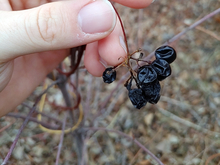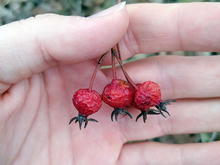In the fall, I prepare for a long couple of days removing invasive honeysuckle and buckthorn. As I hack away at the plants, the largest buckthorns still carry pitch-black fruit on the ends of their branches. I hear a few staccato calls from the robin nearby as I am working. Maybe the critter is upset that I am removing its potential winter snacks.
Until recently, I did not care much. I was told that buckthorn’s fruit has a terrible laxative effect on birds. Whatever poison was in the fruit would help spread the invasive plant faster at the cost of the bird's health. This idea of buckthorn sickening (or even killing) birds is fairly widespread. I came across universities and wildlife agencies that stated something similar. But I found out how flimsy that “fact” is.
Are the birds truly being poisoned?
I was curious about why a plant that needs birds to help spread its seeds would want to harm them. The pieces did not fit. A detailed 2011 blog post by Julie Craves, then at the University of Michigan-Dearborn, got me even more interested in buckthorn’s effects on birds. She noted how little peer-reviewed work existed regarding buckthorn poisoning of birds.
She argued that what might be considered a “laxative effect” of buckthorn is simply what happens when birds eat fruit with a certain nutrient profile. In other words, the laxative effects from buckthorn’s berries (or drupes) need to be compared to other fleshy fruits. Some examples could include wild grapes (Vitis riparia), Canada moonseed (Menispermum canadense), or wild roses (Rosa spp.) These species also all have fruit that can persist in late fall into winter—similar to many buckthorns.
Buckthorn and emodin
One compound in buckthorn’s fruit, emodin, is frequently blamed for hurting the birds. The foliage of native Minnesota buckthorn species alder-leaved buckthorn (Rhamnus alnifolia) contains emodin, though I don't know if it is in the berries. So emodin existed in our state’s woodlands before invasive common (Rhamnus cathartica) and glossy (Frangula alnus) buckthorn arrived.
We know emodin can cause laxative effects in mammals. But only a handful of papers have examined the effects on birds. Unripe berries from buckthorn species often test high for emodin. Once the fruit ripens though, the concentration of emodin goes way down, especially in common buckthorn. Ripe buckthorn fruit is fed upon by a variety of bird species, especially robins and cedar waxwings.
Emodin’s effects on birds
In a 1972 study, birds seemed to be sensitive to how much emodin was present and consistently avoided eating unripe buckthorn berries compared to Morrow’s honeysuckle (Lonicera morrowii) or chokecherry (Prunus virginiana) fruit. Researchers also sprayed chokecherries with emodin to attempt to “trick” the birds, but the animals still knew something was off. Only when the birds were force-fed high amounts of unripe buckthorn fruit, did they become ill. It makes sense that birds aren't attracted to unripe fruit. Plants that rely on birds and other animals to help them propagate produce fruit that is more tasty when ripe. This is so animals don't spread immature seeds that will germinate poorly.
This 1972 paper—possibly the origin of the emodin poisoning myth—used birds kept in laboratory conditions. This is important because in nature there could be other preferred sources of food birds could forage—not just unripe buckthorn berries. There is also evidence that emodin’s effects may depend on the species of bird as well. For one species native to Asia, the yellow-vented bulbul, emodin slowed down digestion instead of speeding it up.
What did we learn?
I was also unable to find definitive, peer-reviewed evidence that buckthorn fruit is a poisonous danger to birds in the wild—even 12 years after Julie Craves' blog post. If anything, the idea that buckthorn poisons birds still spreads. One 2020 study mentioned the bird laxative effect and offered two citations that support it. Following up on the citations, one mentioned the complexity of emodin’s effects—and notably did not say it was harmful to wildlife. The other citation just led to another paper that said buckthorn was spread by birds. Hardly earth-shattering news or support for mass poisoning. Recent articles about emodin appear to focus mainly on human health effects rather than its effects on birds.
While the current evidence is misleading about buckthorn’s effects on wild birds, we know well the damage invasive plants can cause to ecosystems. Consider controlling buckthorn in your woodland, and replace them with native shade-tolerant sedges, grasses and shrubs.
Some shrubs, such as Aronia berry (chokeberry) have fruit that also persists in the winter for birds, so perhaps your robins will not be too grumpy as the buckthorn disappears.
For a list of climate-resilient trees and plants check out Climate-ready woods.
Special thanks to Julie Craves and Alex Wieker for their input on this article.
- Archibold, O. W., Brooks, D., & Delanoy, L. (1997). An investigation of the invasive shrub European buckthorn, Rhamnus cathartica L., near Saskatoon, Saskatchewan. Canadian Field-Naturalist, 111(4), 617-621.
- Craves, J. A. (2011, November 1). Myth-busting: Birds, buckthorn, and diarrhea. Net Results: Birds and urban ecology in the anthropocene. https://net-results.blogspot.com/2011/11/myth-busting-birds-buckthorn-and.html
- Craves, J. A. (2015). Birds that eat nonnative buckthorn fruit (Rhamnus cathartica and Frangula alnus, Rhamnaceae) in eastern North America. Natural Areas Journal, 35(2), 279-287.
- Gosper, C. R., Stansbury, C. D., & Vivian‐Smith, G. (2005). Seed dispersal of fleshy‐fruited invasive plants by birds: contributing factors and management options. Diversity and distributions, 11(6), 549-558.
- Izhaki, I. (2002). Emodin–a secondary metabolite with multiple ecological functions in higher plants. New Phytologist, 155(2), 205-217.
- Knight, K. S., Kurylo, J. S., Endress, A. G., Stewart, J. R., & Reich, P. B. (2007). Ecology and ecosystem impacts of common buckthorn (Rhamnus cathartica): a review. Biological Invasions, 9, 925-937.
- Levey, D. J., & Karasov, W. H. (1989). Digestive responses of temperate birds switched to fruit or insect diets. The Auk, 106(4), 675-686.
- Levey, D. J., Tewksbury, J. J., Izhaki, I., Tsahar, E., & Haak, D. C. (2007). Evolutionary ecology of secondary compounds in ripe fruit: case studies with capsaicin and emodin. In Seed dispersal: theory and its application in a changing world (pp. 37-58). Wallingford UK: CABI.
- Seltzner, S., & Eddy, T. L. (2003). Allelopathy in Rhamnus cathartica, European buckthorn. The Michigan Botanist, 42(2).
- Sherburne, J.A. (1972) Effect of seasonal changes in the abundance and chemistry of the fleshy fruits of northeastern woody shrubs on patterns of exploitation by frugivorous birds. PhD thesis, Cornell University, Ithaca, New York.
- Trial, H., & Dimond, J. B. (1979). Emodin in buckthorn: a feeding deterrent to phytophagous insects. The Canadian Entomologist, 111(2), 207-212.
- Tsahar, E., Friedman, J., & Izhaki, I. (2003). Secondary metabolite emodin increases food assimilation efficiency of Yellow-vented Bulbuls (Pycnonotus xanthopygos). The Auk, 120(2), 411-417.
- Wafer, A., Culley, T. M., Stephens, K., & Stewart, J. R. (2020). Genetic comparison of introduced and native populations of common buckthorn (Rhamnus cathartica), a woody shrub introduced into North America from Europe. Invasive Plant Science and Management, 13(2), 68-75.





